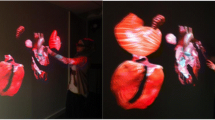Abstract
This case study reports on an investigation of the attitude of education students towards virtual reality (VR) as a tool in the educational process, and towards virtual learning environments on specific disciplines. Our results indicate a favourable attitude towards VR in the educational process. Although immersion was not supported in this study, half of the students declared immersion experiences. Students consider the mouse the most effective input device for navigation in virtual environments, with a joystick the second one. Because the sampling population is small, the qualitative results must be regarded as tentative. There is, however, a need for further investigation, which is currently being undertaken by our group.
Similar content being viewed by others
REFERENCES
Ainge, D. J. (1996) Upper primary students constructing and exploring three-dimensional shapes: a comparison of virtual reality with card nets. Journal of Educational Computing Research, 14(4), 345-69.
Byrne, C. and Furness III, T. (1994) Virtual reality and education. In J. Wright and D. Benzie (eds) Exploring a New Partnership: Children, Teachers and Technology. pp. 181-9. Holland; Elsevier Science.
Dede, C., Loftin, R. B. and Regian J. W. (1994) The design of artificial realities to improve learning Newtonian mechanics. In Proceedings of the East-West International Conference on Multimedia, Hypermedia and Virtual Reality. Moscow, Russia, September, pp. 14-16.
Eddings, J. (1994) How Virtual Reality Works. Emeryville, CA: Ziff Davis Press.
Grove, J. (1996) VR and history-some findings and thoughts. VR in the Schools 1(2), 3-9.
Hereford, J. and Winn, W. (1994) Non-speech sound in human-computer interaction: a review and design guidelines. Journal of Educational Computing Research 11(3), 211-33.
Merickel, M. L. (1993) Virtual reality: magic in the classroom. National Educational Computing Conference Paper (M4.8c). pp. 91-5. Orlando, USA.
Mikropoulos, T., Chalkidis, A., Katsikis A. and Kossivaki P. (1997) Virtual realities in environmental education: the project LAKE. Education and Information Technologies 2(2), 131-42.
Osberg, K. M. (1995) Virtual reality and education: where imagination and experience meet. VR in the Schools 1(2), 1-3.
Pantelidis, V. S. (1993) Virtual reality in the classroom. Educational Technology 23, 23-7.
Psotka, J. and Davison, S. (1994) Cognitive factors associated with immersion in virtual environments. In Proceedings of the 1993 Conference on Intelligent Computer-Aided Training and Virtual Environment Technology. P. R. Hyde and R. B. Loftin (eds), Houston, TX, May, pp. 285-97.
Schaefer, A. and Wassermann K. (1995) Adult students' reactions to low-cost VR. VR in the Schools 1(3), 13-15.
Spaceball 2003 (1993) Manual to the World 410-101. Lowell, MA: Spaceball Technologies Inc.
Space Mouse, User's Manual Version 3.8. Malching, Germany: Space Control Co.
Stuart, R. and Thomas, J. C. (1991) The implications of education in cyberspace. Multimedia Review Summer, 17-27.
Talkmitt, M. (1996) VESAMOTEX-virtual education science and math of Texas. VR in the Schools 1(4), 5-7.
Taylor, G. L. (1994) The potential role of VR in environmental education, unpublished MSc thesis, Ohio State University.
Waterworth, J. A. (1995) HCI design as sensory ergonomics: creating synaesthetic media. In Proceedings of IRIS-18: Information Systems Research Seminar in Scandinavia, Report No 7. B. Dahlbom, F. Kammerer, F. Ljungberg, J. Stage and C. Sorensen (eds), Gothenburg Studies in Informatics, pp. 1-11.
Winn, W. (1993) A conceptual basis for educational applications of virtual reality. Available at ftp.u.washington.edu,/public/Virtual Reality/, August.
Rights and permissions
About this article
Cite this article
Mikropoulos, T.A., Chalkidis, A., Katsikis, A. et al. Students' Attitudes Towards Educational Virtual Environments. Education and Information Technologies 3, 137–148 (1998). https://doi.org/10.1023/A:1009687025419
Issue Date:
DOI: https://doi.org/10.1023/A:1009687025419




